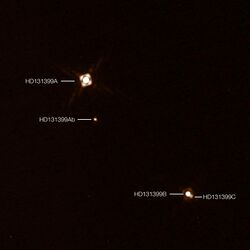Astronomy:HD 131399 Ab
 This annotated composite image shows the suspected exoplanet HD 131399Ab in the triple-star system HD 131399. (The planet is made to appear vastly brighter in comparison to the stars than it would in reality.) | |
| Discovery | |
|---|---|
| Discovered by | Kevin Wagner, Daniel Apai, Markus Kasper et al. |
| Discovery date | 7 July 2016 |
| Direct imaging | |
| Orbital characteristics | |
| ~80 AU | |
| Eccentricity | 0.35±0.25[1] |
| Orbital period | ~550 y |
| Star | HD 131399 A[1] |
| Physical characteristics | |
| Mass | 4.0 (± 1.0)[1] |♃|J}}}}}} |
| Physics | 850 K (577 °C; 1,070 °F) |
HD 131399 Ab (nicknamed Scorpion-1b[2]) was thought, after its discovery in July 2016, to be an exoplanet orbiting the star HD 131399 A, which is part of the triple star system HD 131399, 320 light years from Earth in the constellation Centaurus.[3][4][5] The other two stars orbit each other and jointly orbit HD 131399 A.
In May 2017, observations collected with the Gemini Planet Imager, and including a reanalysis of the SPHERE data, suggested that this target is in fact a background star.[6]
Characteristics
The planet was thought to be about 16 million years old, with a mass of 4 (± 1) MJ (Jupiter masses), and a temperature of 850 K (577 °C; 1,070 °F) (± 50 K), which would make it one of the coldest and least massive directly-imaged exoplanets.[7] Its atmosphere was shown to contain both water and methane through the use of near-infrared spectroscopy (1.4-1.6 μm).[4] Scientists believed it was unlikely that the planet harbored life due to it being gaseous. The planet is said to have "no liquid water, extremely powerful winds, and no surface; just below the uppermost layer of the atmosphere it rains liquid iron droplets."[8]
The central star HD 131399A is orbited by the less massive stars (HD 131399B and HD 131399C) at about 300 astronomical units (AU). HD 131399B and HD 131399C orbit each other at about 10 AU, while the planet orbits HD 131399A at about 80 AU.[7]
One orbit of HD 131399 Ab takes 550 years.[4] During about a quarter of the orbit, 100–140 years, all three suns are visible during a single day: during this period, any spot on the planet is in perpetual sunlight—as the single sun sets, the binary pair rises.[3]
Discovery
HD 131399 Ab was discovered using the SPHERE imager of the Very Large Telescope at the European Southern Observatory, located in the Atacama Desert of Chile , and announced in a July 2016 paper in the journal Science.[3][4] This was the first exoplanet to be discovered by SPHERE and one of very few directly imaged exoplanets. The image was created from two separate SPHERE observations: one to image the three stars and one to detect the faint planet. After its discovery, the team unofficially named the system "Scorpion-1" and the planet "Scorpion-1b", after the survey that prompted its discovery, the Scorpion Planet Survey (principal investigator: Daniel Apai).[2]
Gallery
-
This artist's impression shows the orbit of the planet in the triple-star system.
-
Artist's impression of the system as seen from the planet. HD 131399 A is at the center. The other two stars can be seen in the distance.
See also
- HD 188753 Ab
References
- ↑ 1.0 1.1 1.2 "Planet HD 131399 b". Extrasolar Planets Encyclopaedia. http://exoplanet.eu/catalog/hd_131399a_b/. Retrieved 12 July 2016.
- ↑ 2.0 2.1 Miller, Michael (12 April 2017). "UC mountaineer, galactic explorer". University of Cincinnati. http://magazine.uc.edu/editors_picks/recent_features/scorpion.html. Retrieved 3 May 2017.
- ↑ 3.0 3.1 3.2 "This strange new planet has three suns". CBS News. 7 July 2016. https://www.cbsnews.com/news/planet-with-three-suns-triple-sunrises-sunsets/. Retrieved 7 July 2016.
- ↑ 4.0 4.1 4.2 4.3 Wagner, Kevin (7 July 2016). "Direct imaging discovery of a Jovian exoplanet within a triple-star system". Science 353 (6300): 673–8. doi:10.1126/science.aaf9671. PMID 27386921. Bibcode: 2016Sci...353..673W.
- ↑ information@eso.org. "A Surprising Planet with Three Suns". ESO. https://www.eso.org/public/news/eso1624/. Retrieved 7 July 2016.
- ↑ Nielsen, Eric L. et al. (1 May 2017). "Evidence that the Directly-Imaged Planet HD 131399 Ab is a Background Star". The Astronomical Journal 154 (6): 218. doi:10.3847/1538-3881/aa8a69.
- ↑ 7.0 7.1 "HD 131399Ab: Astronomers Find Super-Jupiter in Triple-Star System | Astronomy | Sci-News.com" (in en-US). http://www.sci-news.com/astronomy/hd-131399ab-super-jupiter-triple-star-system-04008.html.
- ↑ "16-million-year-old planet with three suns discovered". MSN. 8 July 2016. https://www.msn.com/en-gb/news/techandscience/16-million-year-old-planet-with-three-suns-discovered/ar-BBu52Bi?li=BBoPOOl.
External links





